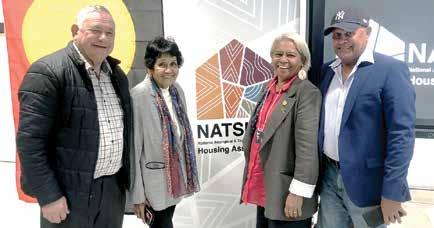
2 minute read
New housing org carries high hopes for better outcomes
BOTTOM:
LEADERS a regional roundtable with a range of community, local, state and federal representatives on Thursday last week.
The Ambassador said the visit aimed to strengthen international ties for the region and understand Torres Strait perspectives on foreign policy.
“It was a privilege to experience the Winds of Zenadth Cultural Festival and meet with elected representatives, cultural leaders and community members to hear directly from local people about their interests in foreign and trade policy,” he said.
“Supporting the meaningful economic development and participation of First Nations peoples in the global system is one very important facet of my role as Ambassador for First Nations People.”
Mr Mohamed was made Australia’s inaugural Ambassador for First Nations People by Foreign Minister Senator Penny Wong, Minister for Indigenous Australians
Linda Burney and Senator Patrick Dodson in March this year.
He brings a strong connection to community to the role, having worked in Torres Strait Islander and Aboriginal health, social justice and reconciliation over decades.
He has been extensively involved in First Nations community-controlled sector, as well as working in government and the corporate sector.
As Ambassador for First Nations People he was responsible for leading the Government’s efforts to embed Indigenous perspectives, experiences and interests across the Department of Foreign Affairs & Trade, and develop a First Nations Foreign Policy Strategy.
For more information visit www.dfat.gov.au/ international-relations/ themes/indigenous-peoples/ ambassador-first-nationspeople
Specialist research, policy and advocacy for First Nations housing was bought together under one roof last month, with the opening of a new office for the National Aboriginal and Torres Strait Islander Housing Association –NATSIHA.

The office in Sydney was opened with a launch attended by Aboriginal and Torres Strait Islander communities and advocates from across the housing and homelessness sector.
Waiben-based Aboriginal and Torres Strait Islander Housing Queensland director Charles Martin said NATSIHA would enable a unified First Nations voice to the Federal government.
“It’s a very useful organisation and it’s trying to bring together all the stakeholders in the states so they can be united into a national voice,” he said. “So as a body NATSIHA, can try and help solve housing problems throughout the country.”
NATSIHA CEO Ivan Simon said they were determined to power progress on First Nations housing.
“There is an enormous challenge ahead of us but NATSIHA is determined to bring solutions to the
The 2021 Census showed 24,930 Aboriginal and/ or Torres Strait Islander people were estimated to be experiencing homelessness, up 6.4 per cent from 23,437 in 2016. This represents one table,” he said. “Housing is at the centre of our lives, and we have an enormous challenge ahead of us to bring solutions to the key challenges of lack of supply of affordable housing and severe overcrowding.
“We are here for the long haul.”
Minister for Indigenous Australians Linda Burney said access to safe and affordable housing was crucial to the wellbeing of Aboriginal and Torres Strait Islander people.
“It affects so many other outcomes, like health, education and family safety,” she said. “I congratulate NATSIHA on the opening of their office and look forward to working with them in future.” in five (20.4 per cent) people experiencing homelessness in Australia. Of the Aboriginal and Torres Strait Islander people experiencing homelessness at the time of the 2021 Census:
NASTIHA Chief Operating Officer Rob Macfarlane said the establishment of NATSIHA brought together some of the most passionate and committed advocates and practitioners in First Nations housing into one organisation.
“We know that a critical part of the solution to the appalling housing disadvantage our people are experiencing is to build the capacity of the community controlled sector that understands and knows how to best meet our community’s needs,” he said.
• Three in five (60.0 per cent) were living in ‘severely’ crowded dwellings
• Almost one in five (19.1 per cent) were in supported accommodation for the homeless
• Nearly one in ten (9.3 per cent) were living in improvised dwellings, tents, or sleeping out.

